Himalayas: An Aesthetic Exploration

Cross listed with ASIAN 335.001. Meets with HISTART 305.001 & ASIAN 582.001
The Himalayas are the world's longest and loftiest mountain range. This course will commence with a survey of influential contemporary perceptions of the Himalayas. Thereafter, we will proceed to glean some of the many ways in which the shaping of objects and the crafting of identities are linked in this region today. Subsequently, we shall embark on a series of armchair expeditions to recover interconnections between 'art' and 'life' in the Himalayas in centuries past. Traveling in arcs stretching from the Brahmaputra River valley in the east up to the upper reaches of the Indus River in the west and along axes extending from the sub-montane Terai in the south to the frosty Tibetan plateau in the north, we will repeatedly cross China, Nepal, India, Pakistan, and Afghanistan. Resting at sites sought out by pilgrims, traders, and conquerors, we will query the distinctive forms, layouts, and functions of temples, monasteries, and gardens, and the medley of objects found in them including steles, manuscript paintings, and water-fountains.
All students will be able to participate in engaging classroom discussions on questions whose ramifications go beyond the classroom 's confines: How does geography impact cultural production? How is nature transformed into art? How do words, images, and edifices operate? Can images and edifices claim legitimacy that words may not and vice-versa? What do makers owe their readers/viewers?
Additionally, students will have an opportunity to examine banners, ritual implements and manuscript paintings in the reserve collections of the U-M Anthropology Museum, Art Museum, and in the Special Collections Library. Graduate students will be encouraged to conduct original research and to write their term papers on topics that can be readily developed into conference presentations.